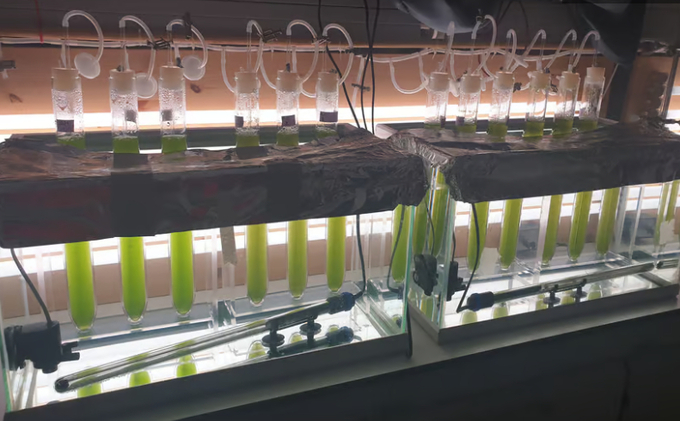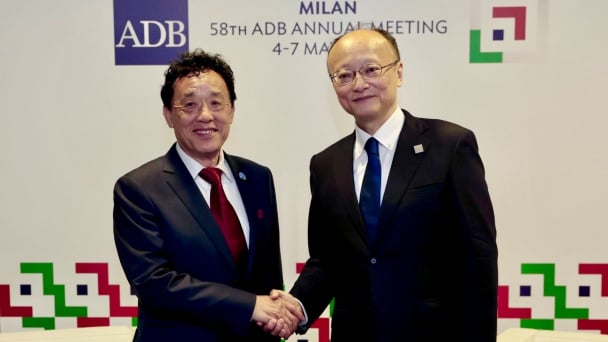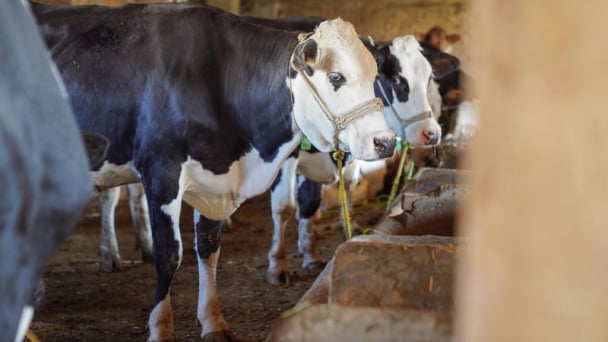May 26, 2025 | 12:57 GMT +7
May 26, 2025 | 12:57 GMT +7
Hotline: 0913.378.918
May 26, 2025 | 12:57 GMT +7
Hotline: 0913.378.918
Scientists have now devised a method of using waste from the former as food for the latter.

Columns of Chlorella vulgaris microlagae, some of which were grown using an insect-frass-based fertilizer.
According to the United Nations' Food and Agricultural Organization, meat production accounts for approximately 14.5% of global greenhouse gas emissions. These emissions mainly take the form of gases such as methane, ammonia and carbon dioxide, which are burped up by cattle, produced by the fertilizers used to grow livestock feed crops, and released by decomposing manure.
Additionally, large areas of forest are routinely cleared in order to create the pastureland or feed-growing cropland required for meat production. This adds to the greenhouse gas problem, as living trees capture carbon dioxide, keeping it from accumulating in the atmosphere – and they release that stored gas once they've been cut down.
Needless to say, deforestation also destroys the natural habitat of many plants and animals, plus it allows the soil to erode into adjacent waterways, filling them with silt.
That's where farmed insects come in, as they're rich in protein, minerals and fatty acids, yet large quantities of them can be raised in facilities much smaller than the pastures required for cattle. Additionally, insects require significantly less food and water than conventional livestock, plus they produce less waste.
That said, they still do produce some waste, which is known as frass. Consisting mainly of insect excrement and molted exoskeletons, it's already utilized as plant fertilizer. Scientists from Norway's University of Bergen and the Norwegian Research Centre (NORCE) are now taking that application a step further, using frass as fertilizer for microalgae.
Although individual microalgae cells are microscopic, they collectively produce a significant amount of protein when grown in large quantities on a commercial scale. That sustainably sourced protein can be added to a wide variety of foods, such as meat alternatives, boosting their nutritional content. Oils produced by microalgae can also be used in the production of biofuel.
For the new EU-funded study, the scientists started with powdered frass obtained from Larveriet, a Norwegian company that raises mealworm larvae as a food product. The researchers mixed that powder with water to release its nutrients, then centrifuged the liquid to remove all the non-soluble particles. In a final step, the solution was sterilized to kill any harmful bacteria that may have been present.
When that frass fertilizer was subsequently added to liquid growth media used to raise Chlorella vulgaris microalgae, the algae grew just as well as it did when raised on existing chemical fertilizers. The frass-fed algae also produced the same amount of protein, at approximately 40% of its dry weight.
The scientists are quick to point out that this was a small-scale experiment, so more research needs to be conducted regarding how the frass fertilizer would work on a commercial scale. They also note that a use needs to be found for the non-soluble particles that are extracted from the frass, which are currently a waste product.
A paper on the research, which was led by NORCE's Pia Steinrücken, was recently published in the journal Bioresource Technology Reports.
newatlas

(VAN) Alt Carbon has raised $12 million in a seed round as it plans to scale its carbon dioxide removal work in the South Asian nation.

(VAN) Attempts to bring down the price of the Japanese staple have had little effect amid a cost-of-living crisis.

(VAN) Fourth most important food crop in peril as Latin America and Caribbean suffer from slow-onset climate disaster.

(VAN) Shifting market dynamics and the noise around new legislation has propelled Trouw Nutrition’s research around early life nutrition in poultry. Today, it continues to be a key area of research.

(VAN) India is concerned about its food security and the livelihoods of its farmers if more US food imports are allowed.

(VAN) FAO's Director-General emphasises the need to work together to transform agrifood systems.

(VAN) Europe is facing its worst outbreak of foot-and-mouth since the start of the century.